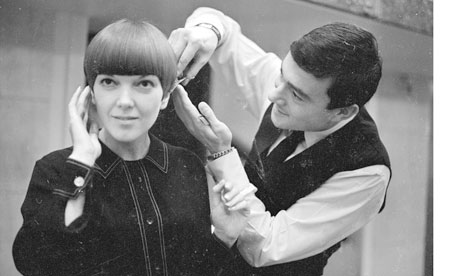
The autobiographies of fashion designers have a tendency to cover up as much as they reveal, which might be an artful indication of their craft, albeit frustrating for the reader. Coco Chanel embarked on several failed attempts with ghostwriters, and then decided against all of them; Christian Dior produced a tantalisingly opaque account of his life, with little in the way of personal detail; while Elsa Schiaparelli was as creative in reinventing her past as she was with her surrealist costumes, leaving the briefest of memoirs behind her.
So it is with Mary Quant's autobiography, which skims through her life with almost as much brevity as the miniskirts that made her famous. The book itself is a solid looking object – too solid, perhaps, for such a stylish subject, with cheap-feeling paper and a paucity of pictures – but the words skitter about all over the place, in an eccentric narrative that incorporates lists but avoids linear convention. Quant's account of how she found herself at the centre of the swinging sixties, as a designer and icon of the era, is impressionistic, and sometimes sketchy.
Her itinerant wartime childhood is dealt with in less than six pages, skipping over her parents, who met at Cardiff University as "the prize pupils of their vintage", thereafter becoming teachers, like Quant's Welsh maternal grandparents. There is an occasional clue about the source of her fashion inspirations; in a school history exam on the roundheads and cavaliers, she declares herself to be on the side of the latter, based on their "accessories, hair styles, hats, make-up, toiletries …" And she spies the "vision of chic" at a childhood dancing class, who will form the basis for her future designs: "A girl with bobbed hair, wearing a black skinny-rib sweater, seven inches of black pleated skirt, black tights under white ankle socks, and black patent shoes…"
It is this girl, an eight or nine-year-old, that Quant takes as her model for the 1960s dolly bird; child-like, with white socks exposing colt legs, a Lolita apparently liberated by the pill. Not that Quant herself is immune to the inconsistencies of the sexual revolution; everyone adores her, but her beloved husband and business partner, the upper-class hipster Alexander Plunket Greene ("a 6'2" prototype for Mick Jagger and Paul McCartney rolled into one") is as unfaithful as his father had been in a previous generation. "Alexander was a hell of a womaniser, like his father, and that makes life bumpy," she admits, in a rare moment of emotional candour, before blaming herself in a manner almost untouched by notions of feminism. "I was working so hard and obsessed with design, so I knew it was partly my fault. Women would telephone me and say, 'Can Alexander come out to play today?' And I would find little presents for him left in the car. The trouble was he was such fun to be with until he became too ill, and by then one cannot do anything about it." Her husband's illness and death at the age of 57 is not referred to again until close to the end of the book, with a cryptic reference to alcohol: "He said he could not live without wine and vodka anyway." Other than that, "he just petered out … I can't bear to write more about Alexander's exit as I will never get over it."
Curiously, Quant's descriptions of the 60s also verge on the hazy – inevitably, perhaps, because of the whirlwind that spun around her – with repetition taking the place of recollection. ("Everything was changing. Chelsea was changing … Change, change, change.") Names are dropped, as visitors swing down the King's Road from the Royal Court Theatre to her boutique, although without much more in the way of context or analysis: "John Osborne, Claire Bloom, Susannah York, Audrey Hepburn, Brigitte Bardot, Leslie Caron and, later, pop artists and musicians like the Beatles and the Stones, photographers David Bailey and Richard Avedon, film directors Stanley Kubrick and Joe Losey, and models like Jean Shrimpton and Twiggy. Why it caused such heated attention from the start is hard to understand…"
When she does write in more detail, it is with considerable panache, as with her evocation of an earlier postwar youth, when rationing still prevailed: "London was a bombsite and the only thing that thrived was the buddleia … If you went out to tea you took your own private plate of rancid butter and kept a sharp eye on it… Fog permeated everything. Fog was a smell. Fog was a colour." In the aftermath of this austerity, a new decade explodes into colour, but not always with the clarity or vividness in Quant's memoir that you might expect.
Nevertheless, this is a story to be cherished (indeed, one wishes that the publishers could have lavished more care on). Quant's understanding of the language of fashion is as astute as the way in which she shaped traditional gentlemen's tailoring, pinstripe City suiting and herringbone tweeds, into the clothes that she and her friends wanted to wear. In this, she had something in common with her predecessor Coco Chanel – that sharp sense of how to turn masculine classics into androgynous style with a feminine twist – and like Chanel, Quant built a global brand out of herself. Whether this can survive with anything like the same success remains uncertain (she resigned as a director 12 years ago from the company that bears her name, after a Japanese buyout). But the hidden history of Mary Quant will continue to be every bit as intriguing as before.
Justine Picardie's Coco Chanel: The Legend
and the Life is published by HarperCollins.

